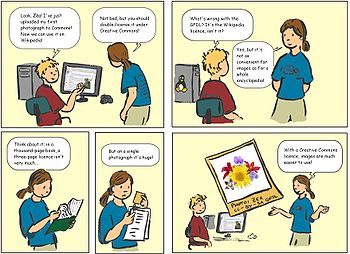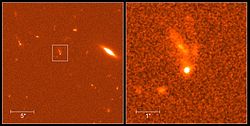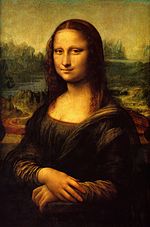Commons:Licensing
Shortcut: COM:L
- For the country-by-country licensing rules, see Commons:Copyright rules by territory.
|
This page gives non-lawyers an overview of complicated copyright laws through an example-based tutorial. It aims to help uploaders decide whether an image or other media file is acceptable on Wikimedia Commons. If you are a re-user looking for information on how to use Commons content in your own work, see Commons:Reusing content outside Wikimedia. Wikimedia Commons only accepts free content, that is, images and other media files that are not subject to copyright restrictions which would prevent them being used by anyone, anytime, for any purpose. The use may however be restricted by issues not related to copyright, though, see Commons:Non-copyright restrictions, and the license may demand some special measures. There is also certain material, the copyrights of which have expired in one country while still applying in another. Some of the details are explained below. Wikimedia Commons tries to ensure that any such restrictions are mentioned on the image description page; however, it is the responsibility of reusers to ensure that the use of the media is according to the license and violates no applicable law. Wikimedia Commons only accepts media
Wikimedia Commons does not accept fair use justifications: see Commons:fair use. Media licensed under non-commercial only licenses are not accepted either. The license that applies to an image or media file must be indicated clearly on the file description page using a copyright tag. All information required by that license must be provided on the description page. The information given on the description page should be sufficient to allow others to verify the license status. It would be best to do this immediately in the summary field on the upload form. If you request permission from a copyright holder, please use the email template to do so. |
Contents
Acceptable licenses
A copyright license is a formal permission stating who may use a copyrighted work and how they may use it. A license can only be granted by the copyright holder, which is usually the author (photographer, painter or similar).
All copyrighted material on Commons (not in the public domain) must be licensed under a free license that specifically and irrevocably allows anyone to use the material for any purpose; simply writing that "the material may be used freely by anyone" or similar isn't sufficient. In particular, the license must meet the following conditions:
- Republication and distribution must be allowed.
- Publication of derivative work must be allowed.
- Commercial use of the work must be allowed.
- The license must be perpetual (non-expiring) and non-revocable.
- Acknowledgment of all authors/contributors of a work may be required.
- Publication of derivative work under the same license may be required.
- For digital distribution, use of open file formats free of digital restrictions management (DRM) may be required.
Sometimes, authors wish to release a lower quality or lower resolution version of an image or video under a free license, while applying stricter terms to higher quality versions. It is unclear whether such a distinction is legally enforceable, but Commons's policy is to respect the copyright holder's intentions by hosting only the lower quality version.
The following restrictions must not apply to the image or other media file:
- Use by Wikimedia only.
- Noncommercial/Educational use only.
- Use under fair use only.
- Notification of the creator required, rather than requested, for all or for some uses.
For example, the following are generally not allowed:
- Screenshots of software that is itself not under a free license. However, screenshots of software under the GPL or a similar free software license are generally considered to be OK. See Commons:Screenshots.
- TV/DVD/Videogame screenshots. See Commons:Screenshots.
- Scans or reproductive photographs of copyrighted artwork, especially book covers, album/CD covers, etc. See Commons:Derivative works.
- Copyrighted symbols, logos, etc. (Not to be confused with trademarks.)
- Models, masks, toys, and other objects which represent a copyrighted work, such as a cartoon or movie character (rather than just a particular actor, regardless of a specific role). See Commons:Derivative works.
Commons also allows works that are not protected by copyright (i.e. works in the public domain). Please read the section about public domain below.
For an explanation of the justification for this licensing policy, see Commons:Licensing/Justifications.
Multi-licensing
You can offer as many licenses for a file as you want as long as at least one of them meets the criteria for free licenses above. For example, files under a "non-commercial" license are OK only if they are at the same time also released under a free license that allows commercial use.
Multi-Licensing with restrictive licenses may be desirable for compatibility with the licensing scheme of other projects; also, multi-licensing allows people who create derivative work to release that work under a restrictive license only, if they wish—that is, it gives creators of derivative works more freedom with regards to which license they may use for their work. See Commons:Multi-licensing.
Well-known licenses
The following well-known licenses are preferred for materials on Commons:
- Creative Commons Attribution/Share-Alike licenses
- GNU Free Documentation License (GFDL)
- GNU General Public License (GPL) / GNU Lesser General Public License (LGPL)
- Free Art License/Licence Art Libre (FAL/LAL)
- Open Data Commons, for freely licensed databases where the contents are also free or available under a free license or cannot be separated from the database [1].
Again, works in the public domain are also accepted (see below). See Commons:Copyright tags for more licenses.
Note: The GFDL is not practical for photos and short texts, especially for printed media, because it requires that they be published along with the full text of the license. Thus, it is preferable to publish the work with a dual license, adding to the GFDL a license that permits use of the photo or text easily; a Creative Commons license, for example. Also, do not use the GPL and LGPL licenses as the only license for your own works if it can be avoided, as they are not really suitable for anything but software.
Works which are not available under a license which meets the Definition of Free Cultural Works are explicitly not allowed. See the Wikimedia Foundation board resolution on licensing for more information.
Some examples of licensing statuses commonly found on the Internet, but forbidden on Commons, include:
- Creative Commons Non-Commercial Only (-NC) licenses
- Creative Commons No-Derivatives (-ND) licenses
- Unlicensed material only usable under fair use, fair dealing, or other similar legal exceptions (see below for the reasons)
Non-permitted licenses may only be used on Commons if the work is multi-licensed under at least one permitted license.
License information
All description pages on Commons must indicate clearly under which license the materials were published, and must contain the information required by the license (author, etc.) and should also contain information sufficient for others to verify the license status even when not required by the license itself or by copyright laws.
Specifically, the following information must be given on the description page, regardless if the license requires it or not:
- The License that applies to the material. This should be done using a copyright tag.
- The Source of the material. If the uploader is the author, this should be stated explicitly. (e.g. "Created by uploader", "Self-made", "Own work", etc.) Otherwise, please include a web link or a complete citation if possible. Note: Things like "Transferred from Wikipedia" are generally not considered a valid source unless that is where it was originally published. The primary source should be provided.
- The Author/Creator of the image or media file. For media that are considered to be in the public domain because the copyright has expired, the date of death of the author may also be crucial (see the section about public domain material below). A generic license template which implies that the uploader is the copyright holder (e.g. {{PD-self}}) is no substitution for this requirement. The only exceptions to this is if the author wishes to remain anonymous or in certain cases where the author is unknown but enough information exists to show the work is truly in the public domain (such as the date of creation/publication).
Of less importance, but should always be provided if possible:
- The Description of the image or media file. What is it of? How was it created?
- The Date and place of creation. For media that are considered to be in the public domain because the copyright has expired, the date of creation may be crucial (see the section about public domain material below).
These points of the description can be done at best using the Information template. For usage of this template see Commons:First steps/Quality and description.
Scope of licensing
In some cases, a document (media file) may have multiple aspects that can and have to be licensed: Every person that contributed a critical part of the work has rights to the results, and all have to make their contribution available under a free license—see derivative work. However, the distinctions are unclear and may differ from country to country. Here are a few examples to clarify:
- For a music recording, the following aspects must be taken into account, and each must be under a free license (or in the public domain):
- The score of the music (rights by the composer)
- The lyrics of the song (rights by the writer)
- The performance (rights by the performers)
- The recording (rights by the technical personnel / recording company)
- For a picture of artwork (also book covers and the like), it is similar:
- The creator of the original artwork has rights to any reproductions and derivative work.
- The photographer has rights to the image, if it is not a plain reproduction of the original.
- For a picture of a building, note that the architect may hold some rights if distinct architectural features are shown, but see also Commons:Freedom of panorama.
This is often problematic, if the artwork is not the primary content of the image or is not clearly recognizable: in that case, usually only the creator of the resulting picture (recording, etc.) holds a copyright. For instance, when taking a photograph of a group of people in a museum, the photo may also show some paintings on the walls. In that case the copyright of those paintings does not have to be taken into account. The distinction however is not very clear. The Commons:De minimis policy has more information about this concept.
Note that the license for all aspects has to be determined and mentioned explicitly. Also note that most reproductions do not allow the person doing the reproduction to claim a new copyright; the creator of a digital image/ reproduction of a picture owns no new copyright to the resulting digital image. The only relevant copyright is that of the original picture. This also applies to Screenshots.
Material in the public domain
Material released under a license like CC-0 is considered the equivalent of public domain material; works that lack originality and edicts are in the public domain; a few governments around the world, including the US Federal, California, and Florida governments place most of their works, including most of their public records in the public domain; the English Wikipedia's guideline on public domain material more precisely defines these many exceptions.
Commons accepts material that is in the public domain, that is, documents allowed by the above exception, or that are not eligible to copyright, or for which the copyright has expired. But the "public domain" is complicated; copyright laws vary between countries, and thus a work may be in the public domain in one country, but still be copyrighted in another country. There are international treaties such as the Berne Convention that set some minimum standards, but individual countries are free to go beyond these minimums. A general rule of thumb is that if the creator of a work has been deceased for more than 70 years, their works are in the public domain in the country the creator was a citizen of and in the country where the work was first published. If the work is anonymous or a collaborative work (e.g. an encyclopedia), it is typically in the public domain 70 years after the date of the first publication.
Many countries use such a copyright term of 70 years. A notable exception is the U.S. Due to historical circumstances, the U.S. has more complex rules. In the United States, copyright generally lasts:
- Works published before 1923 are in the public domain.
- for works first published before 1964, copyright lasts 28 years after publication (and is therefore currently expired) unless the owner filed for renewal (during the window between 27 and 28 years after publication) in which case rights were extended to 95 years after first publication — the large majority of works published before 1964 have passed into the public domain, but it is imperative to determine that copyright was not renewed (which can be done through an online search at the Copyright Office for works published since 1951)
- for works first published before 1978: until 95 years after the first publication
- for works first published 1978 or later: until 70 years after the author's death. Anonymous works or work made for hire: until the shorter of 95 years since the first publication or 120 years since the creation of the work
For works created before 1978 but only published 1978 or later, there are some special rules. These terms apply in the U.S. also for foreign works.
However, the year and location of publication is essential. In several countries, material published before a certain year is in the public domain. In the U.S. this date is January 1, 1923. In some countries, all government-published material is public domain, while in others governments claim some copyright (see Commons:Copyright rules by territory).
In the US, the copyright situation for sound recordings (including those published before 1923) is a complicated special case. Recordings fixed prior to February 15, 1972 may be copyrighted under common law and/or state laws which do not always have the same formalities and limitations as US federal copyright. More details are available at the {{PD-US-record}} talk page and this Wikilegal report.
In some jurisdictions (like the United States), one can also explicitly donate work one has created oneself to the public domain. In other places (like the European Union) this is technically not possible; instead, one can grant the right to use the picture freely with, for example, the Creative Commons Zero Waiver, which waives all rights granted by copyright, but the waiver might not be legally binding in the full extent of what is normally understood as “public domain” (e.g. regarding authors' moral rights).
The Hirtle chart is a tool for helping to determine if something is in the public domain in the United States. Commons:International copyright quick reference guide helps to determine if a work first published outside the United States can be uploaded.
Interaction of US and non-US copyright law
Commons is an international project, but its servers are located in the U.S., and its content should be maximally reusable. Uploads of non-U.S. works are normally allowed only if the work is either in the public domain or covered by a valid free license in both the U.S. and the country of origin of the work. The "country of origin" of a work is generally the country where the work was first published.
When uploading material from a country outside the U.S., the copyright laws of that country and the U.S. normally apply. If material that has been saved from a third-party website is uploaded to Commons, the copyright laws of the U.S., the country of residence of the uploader, and the country of location of the web servers of the website apply. Thus, any licence to use the material should apply in all relevant jurisdictions; if the material is in the public domain, it must normally be in the public domain in all these jurisdictions (plus in the country of origin of the work) for it to be allowable on Commons.
For example, if a person in the UK uploads a picture that has been saved off a French website to the Commons server, the upload must be covered by UK, French and US copyright law. For a photograph to be acceptable for upload to Commons, it must be public domain in France, the UK and the US, or there must be an acceptable copyright license for the photograph that covers the UK, US and France.
Exception: Faithful reproductions of two-dimensional works of art, such as paintings, which are in the public domain are an exception to this rule. In July 2008, following a statement clarifying WMF policy, Commons voted to the effect that all such photographs are accepted as public domain regardless of country of origin, and tagged with a warning. For details, see Commons:When to use the PD-Art tag.
Uruguay Round Agreements Act
- Main page: Commons:URAA-restored copyrights
The Uruguay Round Agreements Act or URAA is a US law that restored copyrights in the U.S. on foreign works if that work was still copyrighted in the foreign source country on the URAA date. This URAA date was January 1, 1996 for most countries. This means that foreign works became copyrighted in the U.S. even if they had been in the public domain in the U.S. before the URAA date. See also Wikipedia:Non-U.S. copyrights.
Because the constitutionality of this law was challenged in court, Commons initially permitted users to upload images that would have been public domain in the U.S. but for the URAA. However, the constitutionality of the URAA was upheld by the U.S. Supreme Court in Golan v. Holder. After discussion, it was determined that the affected files would not be deleted en masse but reviewed individually. There was further discussion about the best method for review of affected files, resulting in the creation of Commons:WikiProject Public Domain.
Files affected by the URAA should be tagged with {{Not-PD-US-URAA}}.
Files nominated for deletion due to the URAA should be evaluated carefully, as should be their copyright status under US and local laws. A mere allegation that the URAA applies to a file cannot be the sole reason for deletion. If the end result of copyright evaluation is that there is significant doubt about the freedom of a file under US or local law, the file must be deleted in line with the precautionary principle.
Fair use is not allowed on Commons
Wikimedia Commons does not accept content under the condition of fair use. See Commons:Fair use.
Derivative works
You want a picture of Mickey Mouse, but of course you can't just scan it in. Why not take a picture of a little action figure and then upload it? Don't. The reason why you can't upload photographs of such figures is that they are considered as derivative works. Such works can't be published without permission of the original creator.
The US Copyright Act of 1976, Section 101, says: "A derivative work is a work based upon one or more preexisting works, such as a translation, musical arrangement, dramatization, fictionalization, motion picture version, sound recording, art reproduction, abridgment, condensation, or any other form in which a work may be recast, transformed, or adapted. A work consisting of editorial revisions, annotations, elaborations, or other modifications which, as a whole, represent an original work of authorship, is a “derivative work”." A photograph of a copyrighted item is considered a derivative work in US jurisdiction. US Copyright Act of 1976, Section 106: "(...) The owner of copyright under this title has the exclusive rights to do and to authorize any of the following: (...) (2) to prepare derivative works based upon the copyrighted work;"
Therefore, "unauthorized" derivative works, like photographs of copyrighted action figures, toys, etc., must be deleted. For more information, see Commons:Derivative works.
Exception: So-called useful articles - objects with an intrinsic utilitarian function, even if commercial designs, are not subject to copyright protection in the US. Consequently, images thereof are not w:derivative works under US law. For details and applicability of this exception, see the Supreme Court’s decision in W:Mazer v. Stein, and {{Useful-object-US}}.
Simple design
Regarding trademarks (see also Commons:Copyright rules by subject matter#Trademarks): Most commercial items and products are protected by intellectual property laws in one way or another, but copyright is only one such protection. It is important to make the distinction between copyright, trademarks, and patents. Wikimedia Commons generally only enforces copyright restrictions, for these reasons:
- Almost anything can be trademarked, and it wouldn't make sense to forbid everything.
- Trademarks and industrial designs restrictions are pertinent to industrial reproduction, but photographs of such items can otherwise be freely reproduced.
→ For these reasons Commons accepts any trademark whose copyright has expired. Moreover, Commons accepts images of text in a general typeface and of simple geometric shapes, even if it happens to be a recent trademarked logo, on the grounds that such an image is not sufficiently creative to attract copyright protection.[1] Such images should be tagged with {{PD-ineligible}} or one of the list of more specific tags for this kind of works (e.g. {{PD-textlogo}} for simple logos).
Raster renderings (i.e. PNG images) of uncopyrighted simple designs can themselves be regarded as being uncopyrighted. For vector images (i.e. SVG files) of uncopyrighted simple designs, the question as to whether the vector representation has its own copyright is less clear; see the English Wikipedia copyright information about fonts and the {{PD-textlogo}} talk page for more information.
It is often very difficult to determine whether a design is protected by copyright or not, and images of these sorts are frequently nominated for deletion, with various results. See Commons:Threshold of originality and/or “Threshold of originality” (in Wikipedia) for some guidance.
Fonts
The raster rendering of a font (or typeface) is not subject to copyright in the U.S., and therefore is in the public domain. It may be copyrighted in other countries (see intellectual property of typefaces on Wikipedia). You should use {{PD-font}} in this case.
Copyright rules
Some guidance on applicable copyright rules can be found at
- Commons:Copyright rules by territory
- Commons:Copyright rules by subject matter (formerly "Commons:Image casebook")
See also
See also
- Copyright tags
- Copyright FAQ for Wikipedia
- Help:Public domain
- Open Content - A Practical Guide to Using Creative Commons Licences (also available as PDF, ISBN 978-3-940785-57-2)
- Stock.xchng Policy
- Commons:WikiProject Permission requests
- Commons:Choosing a license
Notes
- ↑ See Ets-Hokin v. Skyy Spirits Inc where it was decided that the SKYY vodka bottle and logo were not copyrightable
External links
Collections of laws:
- UNESCO collection of copyright laws.
- WIPO Lex.
- CERLALC: Copyright laws of Latin America, the Caribbean states, and Spain and Portugal.
- CIPR: Copyright laws of the CIS nations and the three Baltic states.
- ECAP: Copyright laws of ASEAN countries.
- EuroMed Audiovisual II EU programme; has recent copyright laws of some mediterranean states (from Morocco to Turkey).
Copyright treaties:
- Berne Convention.
- WIPO Copyright treaty.
- EU Council Directive 93/98/EEC on the harmonization of copyright terms in the EU.
Other:
- Circular 38a: International Copyright Relations of the United States, from the U.S. Copyright Office. (A bit dated, some countries are missing.)
- Circular 38b: Highlights of Copyright Amendments Contained in the URAA, from the U.S. Copyright Office.
- 17 USC 104A: Copyright restorations in the U.S. due to the URAA
- Copyright in the USA
|
|||||||||||||||||||||||||||||||||||||||||||||||||||






